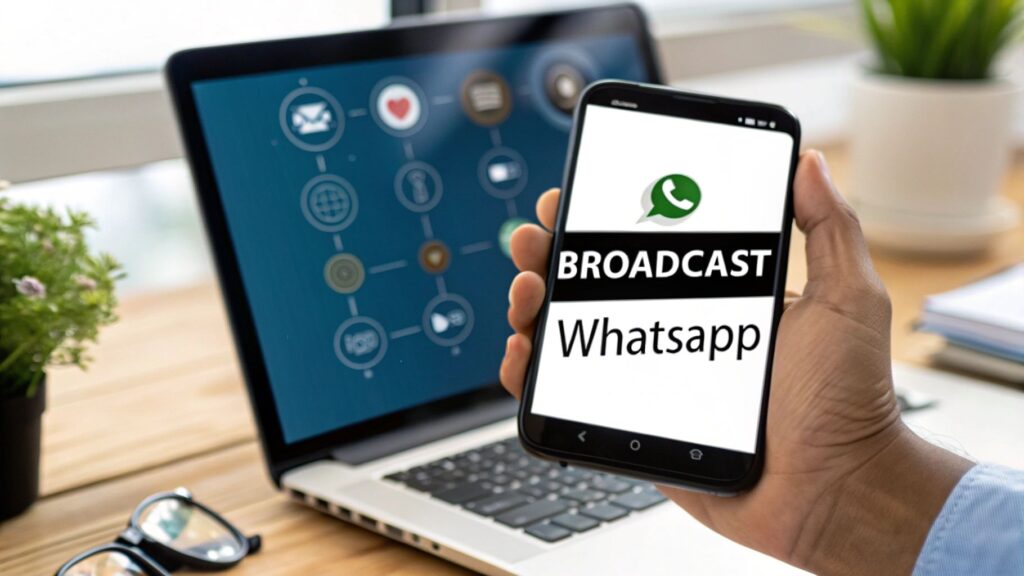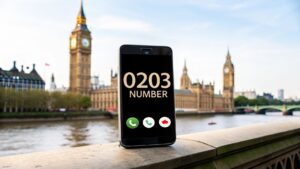So, what exactly is a broadcast WhatsApp message? Think of it as sending a single message to a whole list of people at once, but with a clever twist. Each person on your list gets the message as a private, one-on-one chat. Unlike a group chat, they can't see who else received it, which makes it an incredibly useful tool for professional communication.
Why a WhatsApp Broadcast Beats a Group Chat
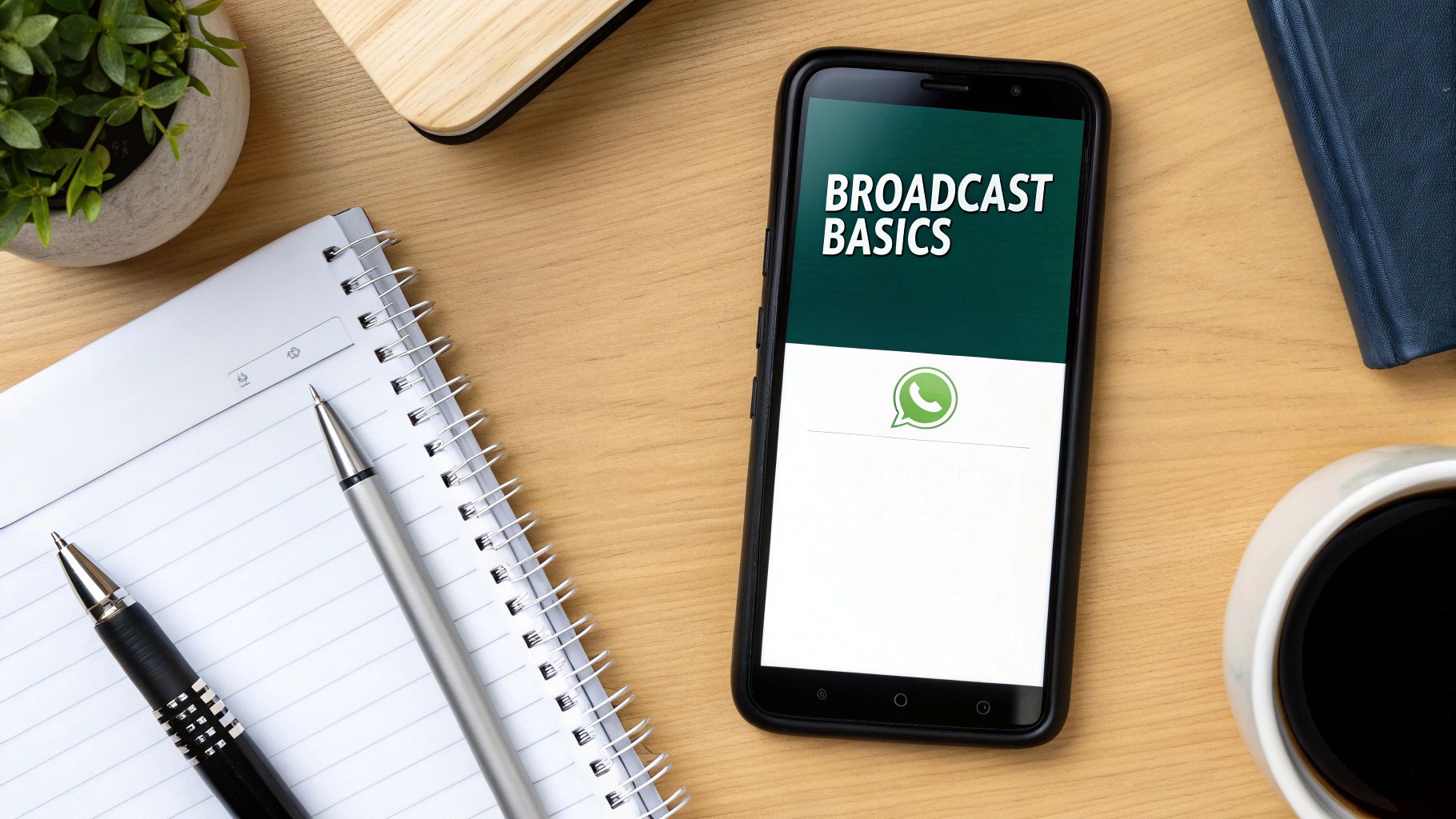
When you need to get the word out, your first thought might be to create a group chat. It’s quick and easy, right? The problem is, for businesses, this usually creates more noise than it’s worth. Group chats can quickly descend into chaos with endless notifications, off-topic conversations, and everyone’s contact details on display for all to see – a bit of a privacy nightmare.
This is exactly where the strategic advantage of a broadcast WhatsApp message comes into play. It gives you all the efficiency of mass messaging without losing the personal feel of a direct conversation.
The Power of Personal, Private Communication
Let’s put this into a real-world context. Imagine a local bakery wants to announce a flash sale on pastries. A group chat would certainly get the message out, but it would also trigger a storm of replies, questions, and side chats that completely bury the original announcement. Those constant pings could even annoy customers enough to make them leave the group for good.
Now, if the bakery uses a broadcast instead, that same offer lands directly in each customer's private inbox. The message feels personal, as if it was sent just for them. Any questions or orders come back as a simple one-to-one reply, letting the owner manage conversations individually and keep things professional.
A WhatsApp broadcast isn't just another feature. It's a direct, personal, and highly effective way to build customer relationships and prompt action in a very noisy digital world.
Reaching Your Audience Effectively
This one-to-one approach, done at scale, is a game-changer for customer engagement. With an estimated 41.4 million users in the UK by 2025, WhatsApp is a massive platform for business communication. Research shows that 33% of UK users really like the immediate nature of messaging a business, and another 28% appreciate being able to get in touch outside of normal hours.
A broadcast message taps right into this preference. It delivers information directly without the pressure of a public forum, making it a much smarter tool for almost any business. If you're interested in the numbers, you can explore more data about WhatsApp usage in the UK for some deeper insights.
To make the distinction crystal clear, let's break down the key differences between a broadcast and a group chat.
Broadcast Message vs Group Chat: A Quick Comparison
Understanding the key differences between sending a broadcast and creating a group chat is crucial for choosing the right tool for the job. Here’s a simple comparison.
| Feature | WhatsApp Broadcast | WhatsApp Group Chat |
|---|---|---|
| Recipient View | Appears as a private, one-on-one message. | A shared conversation space where all members can see replies. |
| Privacy | Recipient contact details are kept private. | All members can see each other's phone numbers. |
| Communication | One-way from sender; replies are private to the sender. | Multi-way; everyone can participate in the conversation. |
| Notifications | Recipients only receive notifications for the message. | Members receive notifications for every message in the chat. |
| Best Use Case | Announcements, promotions, updates, personalised offers. | Team collaboration, event planning, community discussions. |
Ultimately, broadcasts are designed for professional, clean communication, while group chats are built for collaborative discussion. For most business announcements, the broadcast list is undoubtedly the superior choice.
Building Your First Broadcast List The Right Way
Creating a broadcast list on WhatsApp is straightforward enough, but building one that actually gets results takes a bit more thought. Before you even draft your first message, there's one golden rule you need to understand, and it's a big one.
For your message to land in someone's inbox, they must have your business number saved in their phone's contacts. This isn't just a suggestion; it's a hard-and-fast rule from WhatsApp designed to prevent spam. Getting this right from the start is the absolute foundation of any broadcast strategy. It all comes down to building your list on a bedrock of consent and trust.
Getting Customers to Save Your Number
So, the real question is, how do you get people to add your number? You need to make it incredibly easy and give them a compelling reason to do so. Look at all your customer touchpoints and think about where you can add a simple, friendly prompt.
Here are a few ideas that work brilliantly:
- In-Store: A small sign with a QR code by the till can be very effective. Something as simple as, "Scan to save our number for exclusive WhatsApp deals!" works a treat.
- Email Signature: Pop a line in your email signature. "Want order updates on WhatsApp? Save our number: [Your Number]."
- Social Media: Run a small campaign on your social channels encouraging followers to save your details for early access to sales or new product drops.
The aim here is to cultivate an audience that genuinely wants to hear from you. This approach doesn't just guarantee your messages get delivered; it also massively increases the chances they'll actually be read and acted upon.
This is particularly true here in the UK. WhatsApp is woven into the fabric of daily communication. By 2024, it was the most popular messaging app in the country, with an incredible 83% of users opening it every single day. This level of engagement is a goldmine, showing that people are ready and willing to connect on the platform—as long as the communication is welcome. If you want to dive deeper into these figures, the latest UK WhatsApp statistics from Esendex are worth a read.
Once you have people saving your number, the technical side of creating the list is a piece of cake.
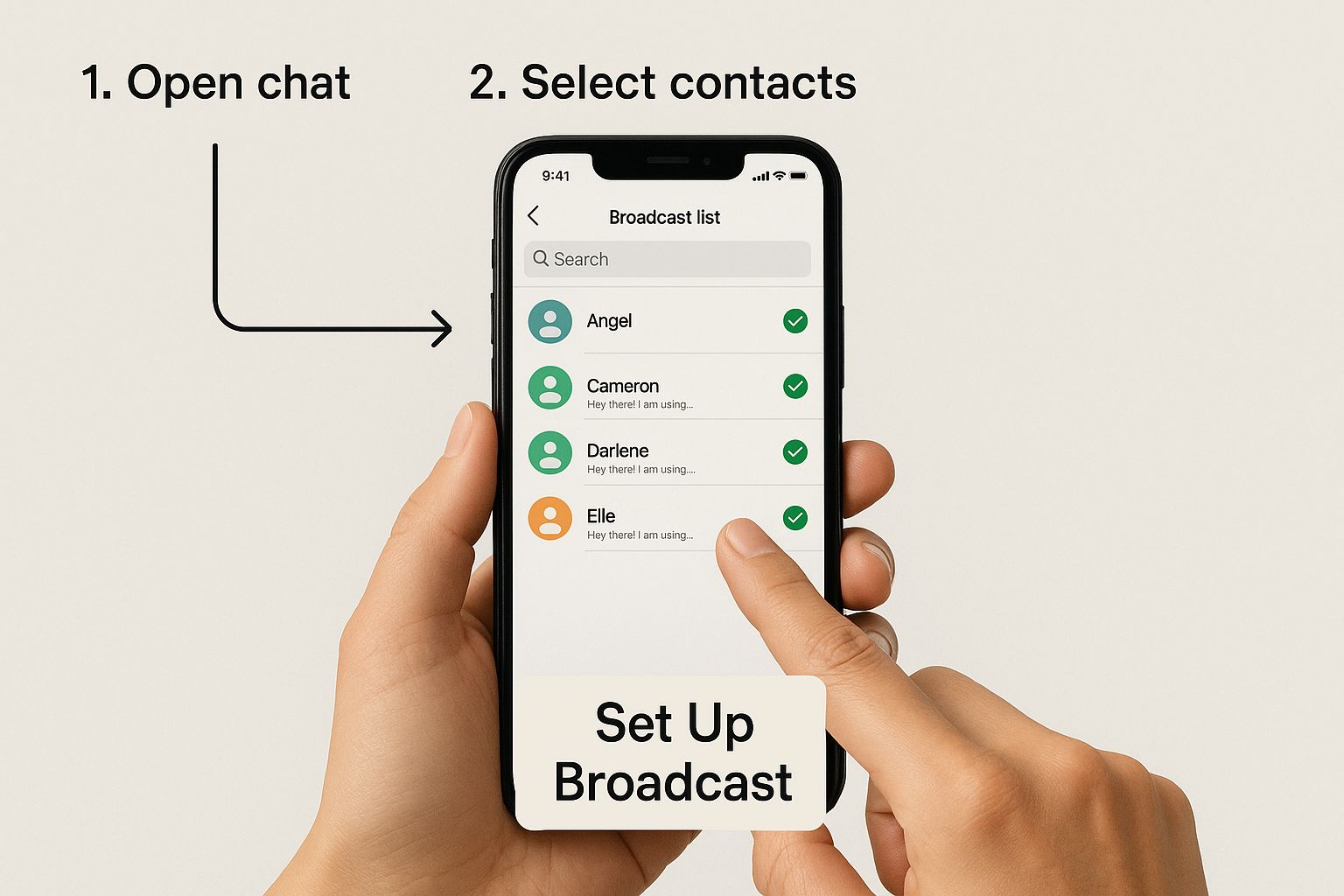
As you can see, the setup itself is just a few taps. That just reinforces that your real energy should be spent on building a high-quality list of people who are genuinely interested.
Remember, a smaller, engaged list of contacts who have opted in and saved your number is infinitely more valuable than a massive list of people who will never even see your message. It's always about quality over quantity.
Crafting Messages That Actually Get Read
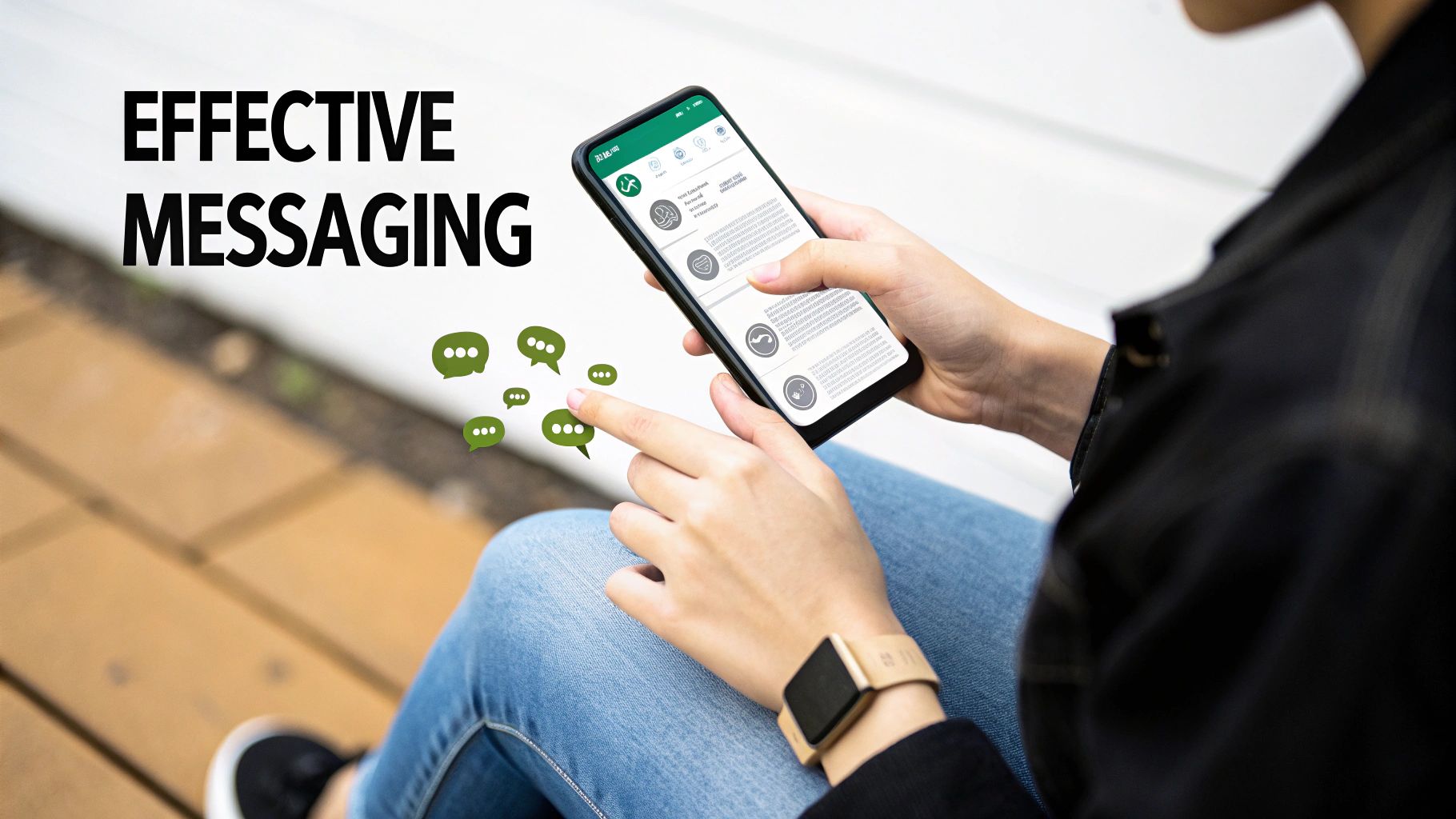
Alright, so you've built your broadcast list. Now for the important part: getting people to actually read what you send. Firing off a broadcast message is simple enough, but the real skill lies in creating something that feels personal and valuable, not like another piece of junk mail.
Remember where your message lands – in a private chat window, squeezed between conversations with your customer's mates and family. To earn its place there, it has to be immediately engaging. If it even smells like spam, you're getting ignored or, worse, blocked.
The Art of the Opening Hook
Your first line is everything. It's your one shot to grab their attention and convince them to keep reading. Ditch the stiff, corporate introductions and get straight to the good stuff.
What would make you stop scrolling? An exclusive offer? Some exciting news? A genuinely helpful tip? Lead with that. Always frame it from their point of view. For instance, instead of a flat "We are now offering a discount," try something punchier like, "Get 20% off your next order today!" It’s direct, highlights the benefit, and adds a touch of urgency.
The secret to a great broadcast is making mass communication feel like a one-to-one conversation. Your message needs to feel like you wrote it just for them, even when it's going out to hundreds of people.
Make Your Messages More Personal
Personalisation is much more than just slotting in a first name. It's about sending the right message to the right people. This is where segmenting your broadcast lists (we'll get into that more later) really starts to pay off. Someone who bought coffee beans last week isn't interested in the same offers as the person who only ever buys tea.
Here are a few simple ways to add that personal touch:
- Mention Past Purchases: "Hi Sarah, just letting you know the Colombian blend you love is back in stock."
- Use Location-Specific Deals: "Flash sale at our Manchester store this weekend only!"
- Reward Their Loyalty: "As one of our VIPs, here’s a sneak peek at our new menu before anyone else."
This kind of detail shows you’re paying attention. It turns your broadcast from a generic announcement into a welcome update. This is how you build relationships, not just a customer list, and it's exactly what services like Business Numbers Direct help you achieve.
Nailing Your Broadcast Management
Sending your first WhatsApp broadcast is just the starting line. The real art lies in managing these campaigns thoughtfully over time to build a loyal audience. It’s less about a single announcement and more about starting a valuable, ongoing conversation.
The aim? To deliver such great content that your contacts actually look forward to hearing from you.
Smart Segmentation is Key
One of the most effective things you can do is segment your audience. Instead of a one-size-fits-all approach, break your contacts down into smaller, more focused groups.
For instance, a local gym could have separate lists for ‘New Members’, ‘Yoga Class Regulars’, and ‘Weightlifting Enthusiasts’. This way, they can send targeted class updates or specialised fitness tips that are genuinely useful to each group, rather than spamming everyone with irrelevant info.
Finding Your Rhythm: How Often to Broadcast
Next up, you need to figure out how often to send messages. There’s no magic number here; it really depends on your business and what your audience expects. A great rule of thumb to start with is one valuable update per week. This keeps you on their radar without being annoying.
The goal is to be a welcome guest in their inbox, not an uninvited pest. If you don't have something genuinely useful or interesting to share, it's better to wait. Quality always trumps quantity.
Remember to make unsubscribing a breeze. A simple, friendly "Just reply 'STOP' if you'd like to unsubscribe" at the end of your message shows respect. It also ensures your list stays full of people who actually want to be there.
Measure What Matters
You can’t improve what you don’t measure. Keeping an eye on a few simple metrics will tell you what’s working and what isn’t.
Start by tracking:
- Coupon Redemptions: How many people actually used that discount code you sent out?
- Link Clicks: Use a link shortener to see how many people clicked through to your website or landing page.
- Reply Rates: Are people responding to your questions or engaging with your offers?
This kind of feedback is gold. It shows you exactly what content hits the mark and what falls flat, helping you fine-tune your strategy for every future broadcast.
To help you stay on the right track, here's a quick cheat sheet for running successful campaigns.
Broadcast Campaign Do's and Don'ts
| Do | Don't |
|---|---|
| Get clear permission before adding anyone to a list. | Add contacts without their consent. This is a fast track to being blocked. |
| Segment your lists for highly relevant content. | Send the same generic message to your entire contact list. |
| Provide real value in every message. | Only send promotional sales messages. |
| Keep it personal and conversational. | Use overly formal or corporate language. |
| Make opting out incredibly simple. | Hide or complicate the unsubscribe process. |
| Test different timings and formats to see what works. | Broadcast at odd hours like late at night or early in the morning. |
Following these simple rules will help you build a broadcast list that not only performs well but also builds genuine trust with your audience.
Sidestepping the Common Pitfalls of WhatsApp Broadcasts
WhatsApp broadcasts can be a game-changer for staying in touch with your audience, but it's a fine line between a welcome update and an outright annoyance. Getting it wrong doesn't just mean your message gets ignored; it can damage your brand's reputation. Let's walk through some of the most common blunders and how you can steer clear of them.
First up, and this is a big one, is broadcasting without explicit consent. Think about it from the customer's perspective: they sign up for delivery notifications and suddenly their phone is buzzing with daily deals they never agreed to. It’s the fastest way to get your number blocked and reported. Always be crystal clear about what people are opting into, and then honour that agreement.
Another classic mistake is simply sending too many messages. It’s easy to get excited and want to share everything, but bombarding your contacts multiple times a week is a recipe for fatigue. Before you know it, people start tuning you out, and when you do have something vital to say, it gets lost in the noise.
The Problem with One-Size-Fits-All Messages
Sending a generic, carbon-copy message to your entire contact list is a massive missed opportunity. It feels impersonal, screams 'mass marketing', and completely misses the point of using a personal channel like WhatsApp. If a message isn't relevant to the person reading it, you're just creating spam.
Imagine a clothing boutique sending a 20% off promotion for its new line of summer dresses to a customer who has only ever purchased men's suits. The message is completely off-target. That kind of communication doesn't just fail to convert; it makes your customers feel like you don't know or care about them.
A broadcast that feels like it was written for everyone will resonate with no one. The real magic happens when each person on your list feels like you're talking directly to them, even when you're sending a message to hundreds.
The solution is to get smarter with your lists. By segmenting your audience into smaller, more focused groups, you can tailor your content properly. A little bit of upfront effort to send messages based on things like purchase history or stated interests shows you see your customers as individuals, not just entries in a database. This simple shift can make all the difference to your engagement and, ultimately, your results.
Got Questions? We've Got Answers
When you're getting to grips with WhatsApp broadcasts, a few questions always seem to pop up. Let's tackle the most common ones we hear from businesses day in and day out.
Will Everyone in the Broadcast See Each Other?
Absolutely not. This is probably the biggest sigh of relief for most businesses. Each message you send through a broadcast list lands as a private, one-to-one chat.
Your customers won't have a clue who else is on the list. It feels personal to them, which is exactly what you want. It’s the key difference that makes broadcasts so much more professional than a massive group chat.
What's the Limit on Broadcast List Size?
WhatsApp caps a single broadcast list at 256 contacts. It’s a built-in measure to keep spam under control.
If your customer base is larger than that, don't worry. The smart move is to create several smaller, segmented lists. For example, you could have one for new customers, another for VIPs, or lists based on location. This actually helps you send more relevant, targeted messages anyway.
I've seen this happen countless times: a broadcast fails and the business owner is stumped. The number one reason is that the recipient hasn't saved your business number to their phone's contacts. It's a non-negotiable WhatsApp rule, so make it a habit to gently remind new customers to save your number.
Ready to manage your business communications professionally and keep them separate from your personal life? Business Numbers Direct can set you up with a dedicated virtual number for WhatsApp Business in under five minutes—no extra SIM card needed. Get your business number today.

